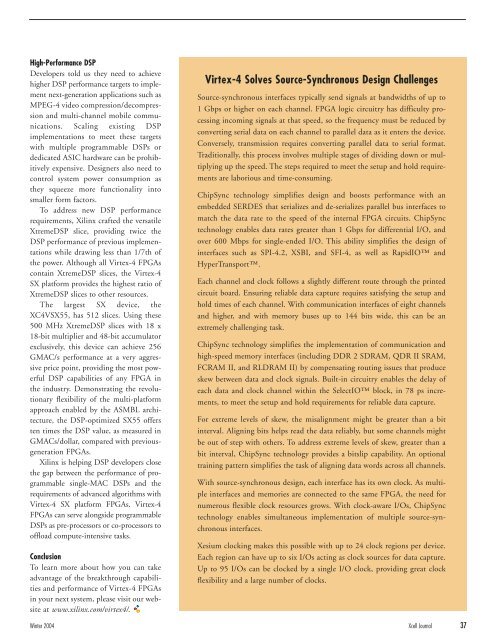Xcell Journal: The authoritative journal for programmable ... - Xilinx
Xcell Journal: The authoritative journal for programmable ... - Xilinx
Xcell Journal: The authoritative journal for programmable ... - Xilinx
Create successful ePaper yourself
Turn your PDF publications into a flip-book with our unique Google optimized e-Paper software.
High-Per<strong>for</strong>mance DSP<br />
Developers told us they need to achieve<br />
higher DSP per<strong>for</strong>mance targets to implement<br />
next-generation applications such as<br />
MPEG-4 video compression/decompression<br />
and multi-channel mobile communications.<br />
Scaling existing DSP<br />
implementations to meet these targets<br />
with multiple <strong>programmable</strong> DSPs or<br />
dedicated ASIC hardware can be prohibitively<br />
expensive. Designers also need to<br />
control system power consumption as<br />
they squeeze more functionality into<br />
smaller <strong>for</strong>m factors.<br />
To address new DSP per<strong>for</strong>mance<br />
requirements, <strong>Xilinx</strong> crafted the versatile<br />
XtremeDSP slice, providing twice the<br />
DSP per<strong>for</strong>mance of previous implementations<br />
while drawing less than 1/7th of<br />
the power. Although all Virtex-4 FPGAs<br />
contain XtremeDSP slices, the Virtex-4<br />
SX plat<strong>for</strong>m provides the highest ratio of<br />
XtremeDSP slices to other resources.<br />
<strong>The</strong> largest SX device, the<br />
XC4VSX55, has 512 slices. Using these<br />
500 MHz XtremeDSP slices with 18 x<br />
18-bit multiplier and 48-bit accumulator<br />
exclusively, this device can achieve 256<br />
GMAC/s per<strong>for</strong>mance at a very aggressive<br />
price point, providing the most powerful<br />
DSP capabilities of any FPGA in<br />
the industry. Demonstrating the revolutionary<br />
flexibility of the multi-plat<strong>for</strong>m<br />
approach enabled by the ASMBL architecture,<br />
the DSP-optimized SX55 offers<br />
ten times the DSP value, as measured in<br />
GMACs/dollar, compared with previousgeneration<br />
FPGAs.<br />
<strong>Xilinx</strong> is helping DSP developers close<br />
the gap between the per<strong>for</strong>mance of <strong>programmable</strong><br />
single-MAC DSPs and the<br />
requirements of advanced algorithms with<br />
Virtex-4 SX plat<strong>for</strong>m FPGAs. Virtex-4<br />
FPGAs can serve alongside <strong>programmable</strong><br />
DSPs as pre-processors or co-processors to<br />
offload compute-intensive tasks.<br />
Conclusion<br />
To learn more about how you can take<br />
advantage of the breakthrough capabilities<br />
and per<strong>for</strong>mance of Virtex-4 FPGAs<br />
in your next system, please visit our website<br />
at www.xilinx.com/virtex4/.<br />
Virtex-4 Solves Source-Synchronous Design Challenges<br />
Source-synchronous interfaces typically send signals at bandwidths of up to<br />
1 Gbps or higher on each channel. FPGA logic circuitry has difficulty processing<br />
incoming signals at that speed, so the frequency must be reduced by<br />
converting serial data on each channel to parallel data as it enters the device.<br />
Conversely, transmission requires converting parallel data to serial <strong>for</strong>mat.<br />
Traditionally, this process involves multiple stages of dividing down or multiplying<br />
up the speed. <strong>The</strong> steps required to meet the setup and hold requirements<br />
are laborious and time-consuming.<br />
ChipSync technology simplifies design and boosts per<strong>for</strong>mance with an<br />
embedded SERDES that serializes and de-serializes parallel bus interfaces to<br />
match the data rate to the speed of the internal FPGA circuits. ChipSync<br />
technology enables data rates greater than 1 Gbps <strong>for</strong> differential I/O, and<br />
over 600 Mbps <strong>for</strong> single-ended I/O. This ability simplifies the design of<br />
interfaces such as SPI-4.2, XSBI, and SFI-4, as well as RapidIO and<br />
HyperTransport.<br />
Each channel and clock follows a slightly different route through the printed<br />
circuit board. Ensuring reliable data capture requires satisfying the setup and<br />
hold times of each channel. With communication interfaces of eight channels<br />
and higher, and with memory buses up to 144 bits wide, this can be an<br />
extremely challenging task.<br />
ChipSync technology simplifies the implementation of communication and<br />
high-speed memory interfaces (including DDR 2 SDRAM, QDR II SRAM,<br />
FCRAM II, and RLDRAM II) by compensating routing issues that produce<br />
skew between data and clock signals. Built-in circuitry enables the delay of<br />
each data and clock channel within the SelectIO block, in 78 ps increments,<br />
to meet the setup and hold requirements <strong>for</strong> reliable data capture.<br />
For extreme levels of skew, the misalignment might be greater than a bit<br />
interval. Aligning bits helps read the data reliably, but some channels might<br />
be out of step with others. To address extreme levels of skew, greater than a<br />
bit interval, ChipSync technology provides a bitslip capability. An optional<br />
training pattern simplifies the task of aligning data words across all channels.<br />
With source-synchronous design, each interface has its own clock. As multiple<br />
interfaces and memories are connected to the same FPGA, the need <strong>for</strong><br />
numerous flexible clock resources grows. With clock-aware I/Os, ChipSync<br />
technology enables simultaneous implementation of multiple source-synchronous<br />
interfaces.<br />
Xesium clocking makes this possible with up to 24 clock regions per device.<br />
Each region can have up to six I/Os acting as clock sources <strong>for</strong> data capture.<br />
Up to 95 I/Os can be clocked by a single I/O clock, providing great clock<br />
flexibility and a large number of clocks.<br />
Winter 2004 <strong>Xcell</strong> <strong>Journal</strong> 37

















